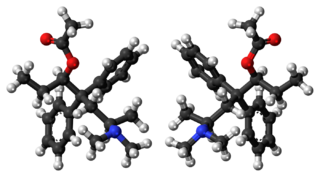Chemistry:Alphacetylmethadol
From HandWiki
Short description: Synthetic opioid analgesic drug
Not to be confused with acetylmethadol[1]
 | |
 | |
| Clinical data | |
|---|---|
| ATC code |
|
| Legal status | |
| Legal status |
|
| Identifiers | |
| |
| CAS Number | |
| PubChem CID | |
| ChemSpider | |
| UNII | |
| KEGG | |
| ChEMBL | |
| Chemical and physical data | |
| Formula | C23H31NO2 |
| Molar mass | 353.506 g·mol−1 |
| 3D model (JSmol) | |
| |
| |
Alphacetylmethadol (INN), or α-acetylmethadol (AAM), is a synthetic opioid analgesic.[2] Its levorotary enantiomer, levacetylmethadol, is an FDA-approved treatment for opioid addiction; however as of 2003 it is no longer used in the United States for this purpose.[2] Alphacetylmethadol is very similar in structure to methadone, a widely prescribed treatment for opioid addiction. In the United States , it is a Schedule I controlled substance under the Controlled Substances Act (presumably because it was never marketed in the US, as is the case with other common opiate/opioid medications such as heroin and prodine),[3] with an ACSCN of 9603 and a 2013 annual manufacturing quota of 2 grammes.[citation needed]
See also
References
- ↑ Richard Lawrence Miller (30 December 2002). The Encyclopedia of Addictive Drugs. Greenwood Publishing Group. p. 222. ISBN 978-0-313-31807-8. https://books.google.com/books?id=G7As-qawdzMC&pg=PA222. Retrieved 15 May 2012.
- ↑ 2.0 2.1 "Heroin discriminative stimulus effects of methadone, LAAM and other isomers of acetylmethadol in rats". Psychopharmacology 164 (1): 108–14. October 2002. doi:10.1007/s00213-002-1198-8. PMID 12373424.
- ↑ 21 U.S.C. § 812(b)(1)
| |||||||||||||||||||||||||
| MOR |
|
|---|---|
| DOR |
|
| KOR |
|
| NOP |
|
| Unsorted | |
| Others |
|
fi:Metadoli#Johdannaiset
 | 0.00      (0 votes) (0 votes) |
